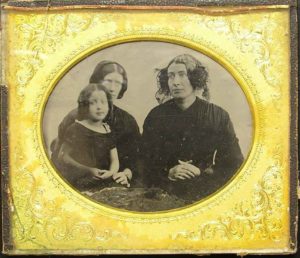
Picture made from human hair. Lockets of hair were popular also after loved ones had departed
The relationship between death and women is one of the least explored aspects of the history of death, but one which is very interesting. Women traditionally have been considerably involved in the processes associated with death, dying and bereavement.
The thinking of our ancestors was so different from our responses today. Most had common experiences of death whereas many people today do not have the same experience. Most people today die in hospitals or in special care facilities. Today death is more sterilised and medicalized and has become more and more removed from our day to day life. It has become feared rather than celebrated.
In the early days of colonial Victoria funerals were often primitive affairs. Harriet Brooksbank died in Ballarat from fever aged only six years old. Her father buried her on 20 February 1854. He recalled, ‘I had great trouble at this time, as one of my children died very suddenly, and these trials were trials in these times. No one to make a coffin, as one man volunteered to make one but when I looked for the coffin he said he had clean forgot it; and two men went to dig the grave and got bushed, so I had to go and dig it myself. This is not very pleasant to do for your own children’.
The magnificent sight of the Victorian funeral however soon became popular. One of the largest funerals held in Victoria was that of Burke and Wills. Photographs of this funeral show the order of people and coaches associated with the funeral. Mutes and other attendants carrying the trappings of mourning preceded the leading coach which was the hearse. This consisted of black with glass sides, inside which the coffin could be seen. The coffin itself was draped with black, purple or dark green cloth, and the whole of the interior was laden with flowers. Black horses with plumes of black ostrich feathers pulled the coach. Behind the hearse came coaches containing mourners in strict order prescribed by etiquette and social custom.
Gentlemen wore full mourning dress with crape bands around their top hats. The ladies were dressed in black with black veils, many yards of crape, black edged handkerchiefs, and black gloves. The deaf ladies carried special mourning trumpets of Vulcanite covered with black silk and decorated with lace and ribbon on silk cords. Mourning fans of black ostrich feathers on tortoiseshell sticks were also carried, and mourning jewellery of jet, cameo, pearl, gold or silver would be worn.
Women were not encouraged to attend the burial. The whole thing was extremely contradictory. Women were prized for their delicacy, and femininity, and yet they had to deal with sickness and death, and lay out the corpse. They were not expected to attend the burial, because it was thought that they were more emotional than men and may make a scene at the grave site. It was proper in Victorian times to show little emotion and to be always reserved. Women however were expected to organise the entire family and see that mourning was properly carried out no matter what class they came from. Many families went heavily into debt to pay for a large and ostentatious funeral. It was considered disrespectful to the departed if protocol was not adhered to.
